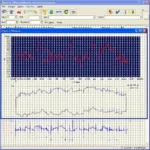An OBD2 EGR error, indicated by specific diagnostic trouble codes (DTCs), signals a problem within your vehicle’s Exhaust Gas Recirculation (EGR) system. This article delves into the complexities of this system, helping you understand the causes of these errors, how to diagnose them, and potential solutions. Learn how to address this issue effectively and get your car back on the road.
What is the EGR System and Why is it Important?
The EGR system plays a crucial role in reducing harmful nitrogen oxide (NOx) emissions. It does this by recirculating a portion of exhaust gases back into the intake manifold, effectively lowering combustion temperatures. This process is essential for meeting environmental regulations and maintaining a cleaner, healthier environment.
A malfunctioning EGR system can lead to various problems, from reduced fuel efficiency and increased emissions to rough idling and even engine damage. Therefore, understanding the OBD2 EGR error codes and addressing them promptly is crucial. gm obd2 custom pids offer advanced diagnostic capabilities for certain vehicle makes.
Common Causes of OBD2 EGR Errors
Several issues can trigger an OBD2 EGR error code. One common culprit is a faulty EGR valve. Carbon buildup can obstruct the valve, preventing it from opening and closing correctly. Other potential causes include:
- Blocked EGR passages: Just like the valve itself, the passages that carry exhaust gases can also become clogged with carbon deposits, hindering proper EGR flow.
- Faulty EGR cooler: The EGR cooler lowers the temperature of the recirculated exhaust gases before they enter the intake manifold. A malfunctioning cooler can disrupt this process and trigger an error code.
- Vacuum leaks: The EGR system often relies on vacuum pressure to control the EGR valve. Leaks in the vacuum lines can disrupt this control and cause the system to malfunction.
- Sensor problems: The various sensors associated with the EGR system, such as the EGR temperature sensor or the Differential Pressure Feedback EGR (DPFE) sensor, can fail and provide inaccurate readings, leading to an error code.
How to Diagnose an OBD2 EGR Error
Diagnosing an OBD2 EGR error requires a diagnostic scanner, like an ezbid obd2, which allows you to read the specific DTCs stored in your vehicle’s computer. Once you have the code, you can begin troubleshooting. This often involves visually inspecting the EGR valve and related components for signs of damage or carbon buildup, checking for vacuum leaks, and testing the relevant sensors.
What does an EGR code mean?
An EGR code indicates a problem within your vehicle’s exhaust gas recirculation system.
How do I fix an EGR code?
Fixing an EGR code involves diagnosing the specific cause, which can range from a faulty EGR valve to blocked passages. Cleaning or replacing components are common solutions.
Can I drive with an EGR code?
While you might be able to drive with an EGR code, it’s not recommended. Continued driving can worsen the issue and potentially lead to further damage.
“Regular maintenance, including cleaning the EGR valve, can prevent many EGR-related problems,” advises John Miller, a certified automotive technician with over 20 years of experience. “A proactive approach can save you time and money in the long run.”
Fixing an OBD2 EGR Error
Depending on the specific cause of the error, fixing it might involve cleaning the EGR valve and passages, replacing a faulty EGR cooler, repairing vacuum leaks, or replacing a faulty sensor. In some cases, the entire EGR valve might need to be replaced.
Conclusion
Understanding and addressing OBD2 EGR errors are crucial for maintaining your vehicle’s performance, reducing emissions, and preventing potential engine damage. Using an OBD2 scanner and understanding the different components of the EGR system will empower you to tackle these issues effectively. If you need a reliable OBD2 scanner, check out our obd2 charger. Remember, addressing these codes promptly can save you money and headaches in the long run.
FAQs
-
What is the most common cause of an OBD2 EGR error? A faulty EGR valve due to carbon buildup is often the main culprit.
-
Can I clean the EGR valve myself? Yes, with the right tools and some mechanical aptitude, you can clean the EGR valve.
-
How often should I clean the EGR valve? Consult your vehicle’s maintenance schedule for recommended cleaning intervals.
-
What happens if I ignore an OBD2 EGR error? Ignoring the error can lead to worsened fuel efficiency, increased emissions, and potential engine damage.
-
How much does it cost to replace an EGR valve? The cost varies depending on the make and model of your vehicle but generally ranges.
-
Are there any preventative measures for EGR problems? Regular maintenance, including cleaning the EGR valve and related components, can help prevent issues.
“Using a quality OBD2 scanner is essential for accurately diagnosing and fixing any OBD2 error, including EGR codes,” adds Maria Sanchez, a senior automotive engineer specializing in emissions control systems. “It’s a valuable tool for any car owner.”
You can find valuable resources for DIY OBD2 projects at arduino obd2 source. For information on the differences between OBD2 standards, you might find this article helpful: obd2 r3 obd2 r2 違い.
Need support? Contact us via WhatsApp: +1(641)206-8880, Email: [email protected], or visit our office at 789 Elm Street, San Francisco, CA 94102, USA. Our customer service team is available 24/7.

